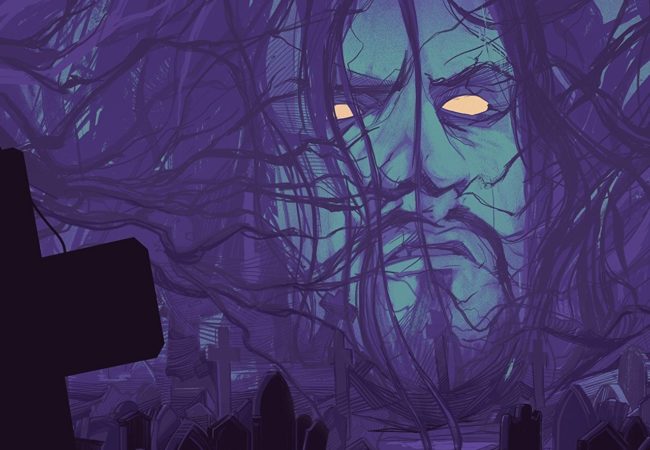Undertaker: Rise of the Deadman
Chad Dundas (writing); Rodrigo Lorenzo, Edu Menna, Serg Acuna, Kelly Williams, Travis Hymel, Tim Lattie, Kendell Goode (art); Weselli Manoel, Vladimir Popov, Doug Garbaok (colors); Deron Bennett (letters); Cover Art: Oliver Barrettt
Boom!Studios
October, 2018
With the Undertaker preparing for what’s likely to be a final retirement from the wrestling business, Boom!Studios takes a look back at his official canon mythology in Undertaker: Rise of the Deadman.
 It’s an interesting experience as a graphic novel and as a look into the history of one of the longest-lived careers in WWE history. Even within the limited scope of being a zombie-like funeral parlor owner, turned cult leader, turned biker, turned back into a supernatural funeral parlor owner, The Undertaker’s seen a number of big changes to his onscreen personality and backstory.
It’s an interesting experience as a graphic novel and as a look into the history of one of the longest-lived careers in WWE history. Even within the limited scope of being a zombie-like funeral parlor owner, turned cult leader, turned biker, turned back into a supernatural funeral parlor owner, The Undertaker’s seen a number of big changes to his onscreen personality and backstory.
Dundas tries to weave together all of the varying contradictory bits and tangents into something that feels mainly cohesive and grounds the Undertaker in a world of sincerity and dignity. Which is no easy feat when your brother’s been accused of killing a cheerleader while drunk driving and you once ascended to heaven and were later the subject of an investigation by Lieutenant Frank Drebin of Police Squad!
The book does a very good job of taking the bits of canonical information we have about the Undertaker character (a childhood blighted by his brother Kane’s jealousy and a parent-killing fire, teen years spent working for Paul Bearer at his funeral home, being brought into the WWF by Ted DiBiase, at least two different canonical tales about what happened to their parents, and every single onscreen evolution that took him from pawn of DiBiase to record-setting Phenom) and weave them into something linear.
When this works it works very well, like in portraying the brotherly bond between Kane and Taker. When it doesn’t (how does the Undertaker figure out that his parents are buried back on the property where their funeral home was, and why didn’t the people at the orphanage tell him so in the first place years ago?) it’s only slightly goofy. At the very root of the matter is the Undertaker’s belief in fairness and justice, and Paul Bearer’s love of money.
 The art is generally decent, but in a few panels the characters are plagued with elbows-don’t-work-that-way-itis. The first couple of issues don’t really capture Glenn Jacobs’ face, but then when the art switches during issue #3 (which proves pretty distracting), it captures his visage better than ‘Taker’s. The color work is what’s super exceptional here. Weselli Manoel, Vladimir Popov, and Doug Garbaok all do excellent work portraying the shadowed universe and bright sun-dappled moments of golden beauty that fill Taker’s world. The panel design is nicely inventive, occasionally jagged, and sometimes contemplative and pensive.
The art is generally decent, but in a few panels the characters are plagued with elbows-don’t-work-that-way-itis. The first couple of issues don’t really capture Glenn Jacobs’ face, but then when the art switches during issue #3 (which proves pretty distracting), it captures his visage better than ‘Taker’s. The color work is what’s super exceptional here. Weselli Manoel, Vladimir Popov, and Doug Garbaok all do excellent work portraying the shadowed universe and bright sun-dappled moments of golden beauty that fill Taker’s world. The panel design is nicely inventive, occasionally jagged, and sometimes contemplative and pensive.
I’ve read at least three different comic versions of the Undertaker’s origin story, and trust me when I say for those who really enjoy the Undertaker’s legacy, this is undoubtedly the best comic-based version of his story, even with its minor flaws.

